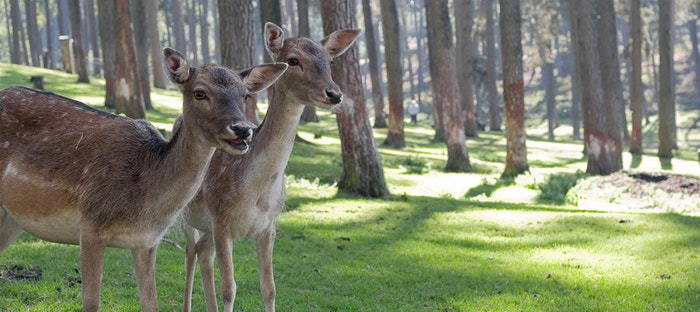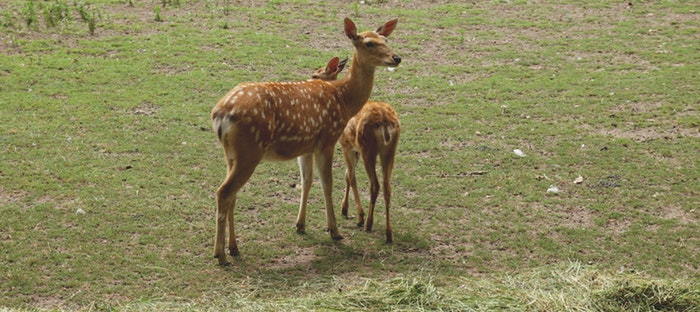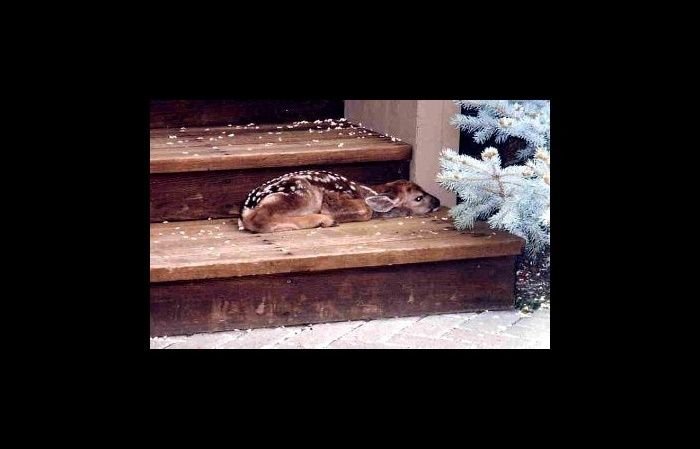What to Do if There Is a Baby Fawn Under Your Tree and No Mother in Sight
What To Do If You Notice A Fawn

People sometimes find a healthy newborn fawn in their chiliad. If they don't see the mother, they might call back the baby has been abandoned and needs assist. This is ordinarily not the example.
Fawns are normally born sometime between tardily April and early July. Does nascence 1, 2 or occasionally three fawns. Finding one alone presents a situation when what not to practise is equally of import as what to practice. If you find a fawn, don't move it. A female parent doe will put her baby in a place she thinks is safe, commonly in tall grass, about a tree or bush, or sometimes near a firm. What seems condom and hidden to her at dusk or dawn may not be safe one time humans, pets, and cars starting time moving nigh. She volition nurse her babe, stimulate information technology to eliminate and clean that upwards so there is no scent. The doe will then leave the baby solitary because she knows her fawn does not have any scent for the first few weeks of its life. Nonetheless, she does. If she stays with her baby, her aroma will attract predators. So she leaves it solitary for hours at a fourth dimension. She may return in the middle of the day, just most oftentimes returns at dawn and dusk and volition usually move the fawn to a new location.

The baby's strong natural instincts tell information technology to stay where it is until the female parent returns. It may movement effectually a few feet every bit its legs get stronger, just will mainly stay hidden near where the mother left it. If something approaches, a healthy fawn may flatten itself to the basis and freeze in an endeavor to blend in.
If the fawn is lying quietly and is not crying more than than a few calls, in that location is a very good take a chance its mother has been back and fed it recently and will render over again. Information technology is non true that animate being mothers will carelessness babies that have been touched by humans. Creature mothers want their babies fifty-fifty if a human has touched them. By and large, mother doe will come up back for her baby. Just she may exist too frightened to come up back until the area is articulate of all human being activity.
 (deer browsing sunchoke foliage in my chiliad, then drank all the water in the bird baths)
(deer browsing sunchoke foliage in my chiliad, then drank all the water in the bird baths)
Practise not motion the fawn. People should move far away from the baby and all dogs should be moved inside and contained to give the female parent a chance to render. If y'all have moved the baby, put it dorsum where you found it, facing information technology away from yous. Quickly run abroad earlier information technology follows. If information technology tries to follow, repeat. Even if it moves, it will want to stay near the embrace of the woods and eventually settle downwardly. If it's hungry, its call will bring mother doe. This may take hours. She may wait until sunset or dawn or she may return in the centre of the day, just she will render once the area is void of activity. A few hours after the adjacent dawn or dusk you can return only close enough to check if the baby is gone. Usually it volition exist. Remember that no ane can treat and teach survival skills amend than a wild animal's own mother.

Yet, if a the fawn is bleeding or patently injured, covered in flies or maggots, running effectually frantically, crying nonstop, running after you, lying stretched out on its side, next to its dead mother, has been left well by the adjacent dawn or sunset, is in danger from cars or roads, or is stuck in a fence, contact Brute Command. Do not feed the fawn moo-cow'south milk, infant formula, puppy formula, goat'southward milk or any other milk or formula. These can cause severe diarrhea and kill a fawn. A small corporeality of Pedialyte, Gatorade, or Smart H2o at room temperature in a baby bottle will help hydrate a fawn temporarily. Put the injured fawn in a covered domestic dog crate or solitary in a minor room away from people, pets, and noises. To minimize stress, brand sure information technology's in a warm expanse that is as quiet and nighttime as possible.

Do not attempt to continue the creature. Wild animals require dissimilar care than domestic pets do. Fawns accept delicate digestive systems. Fifty-fifty a caring person tin can feed the wrong food and cause more harm than skillful. A human being cannot teach a fawn natural survival skills such as how to retain its natural fears which are necessary to survive in the wild.
Like humans, infant wild fauna spend every waking moment learning from their own kind how to survive. They acquire what they're supposed to do, who they belong with, what to eat, where it'southward safe to play, live, slumber, hide, eat, how to get along with others of their kind, and the rules of being a member of a herd. They also learn when to stand their ground and when running away tin can save their lives. Wild animals that grow upwards with humans cannot learn these survival skills. They grow upwards believing they belong with humans. They cannot adapt to life and survival in the wild. When they go adults, grow difficult to maintain, and with no skills for surviving in the wild, if released they become like shooting fish in a barrel prey for the first predator that comes along. If kept captive, they tin get unsafe.
 (White-tailed deer with chronic wasting illness)
(White-tailed deer with chronic wasting illness)
Annotation of circumspection: Chronic wasting affliction (CWD) is a contagious transmissible spongiform encephalopathy (TSE) of mule deer, white-tailed deer, elk, moose, and reindeer. Equally of 2016, CWD had been found in members of the deer family unit simply. It causes a spongy degeneration of the brains of infected animals resulting in emaciation, abnormal behavior, loss of bodily functions and death.
Always make choices that are best for the orphaned or injured fawn and for whatsoever other wild animal. Contact animal control equally soon every bit possible so the deer can be properly cared for and eventually returned to the wild with all the skills it needs to survive.
(Sources: (https://www.wildwatch.org/firstaid/feeddeer.htm; http://cwd-info.org/faq/; http://www.fawnrescue.org/fawncare.html; https://web log.nwf.org/2015/04/finding-a-fawn-what-to-do/)
What to Do if There Is a Baby Fawn Under Your Tree and No Mother in Sight
Source: https://davesgarden.com/guides/articles/what-to-do-if-you-find-a-fawn

0 Response to "What to Do if There Is a Baby Fawn Under Your Tree and No Mother in Sight"
Post a Comment